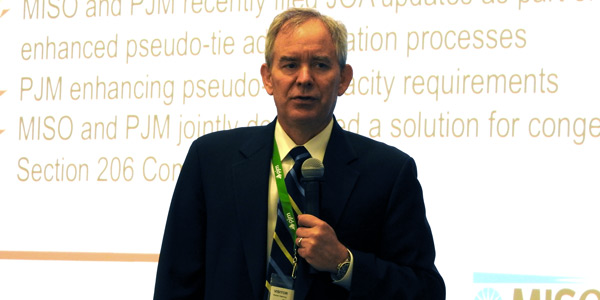By Rory D. Sweeney
VALLEY FORGE, Pa. — PJM and MISO staff provided updates on their proposed pro forma pseudo-tie agreements, the “freeze date” on transmission rights and targeted transmission upgrades at their Joint and Common Market meeting Aug. 22.
Pseudo-Tie

MISO’s Kevin Vannoy told stakeholders that FERC accepted the RTO’s pro forma pseudo-tie agreement Aug. 9 with an effective date of March 15, though it was approved in a delegated order and could be subject to further review and refunds now that the commission has a quorum (ER17-1061). (See FERC Conditionally OKs MISO’s Pseudo-tie Pro Forma.)
PJM’s pro forma agreement, filed on Aug. 11, awaits FERC approval. The grid operators filed revisions to their joint operating agreement to address PJM’s pro forma on Aug. 1.
PJM has until Sept. 17 to respond to a deficiency notice on its Tariff revisions for pseudo-tie requirements, which were filed March 9 (ER17-1138). (See MISO, PJM to Try Again on FERC Pseudo-Tie Filings.)
The grid operators next plan to address the “congestion overlap” that is causing some congestion to be charged twice and has led to complaints at FERC. The issue, which occurs when an associated market-to-market constraint binds in both markets, will require a two-phase solution.


“It’s a complex solution” that can’t be done in a single implementation, PJM’s Tim Horger explained.
The first phase, which the grid operators hope to have implemented by Dec. 1, would include JOA changes to better model the impacts of firm-flow entitlements before the day-ahead dispatch is modeled. This will allow day-ahead LMPs for pseudo-tied resources to more accurately reflect expected real-time congestion. The balancing authority receiving the power will receive credit for the flow from the generation unit to the border, while the source balancing authority will model its impacts as loop flows.
“We think it’s a major step and will remove most of the overlap,” Horger said.
The second phase will allow for mitigating day-ahead charges either through refunds or virtual transactions to align transmission usage charges with available financial transmission rights hedges.
The RTOs plan to file JOA changes implementing market-to-market adjustments in September, with implementation of the phase one solution by the end of December. Dec. 1 is the target date for filing additional JOA and tariff changes. Phase two is scheduled for implementation by June 1, 2018.
Freeze Date Update

The grid operators have been using an April 1, 2004, “freeze date” to determine firm rights on flowgates, but issues with that date have “become prominent” over time, the RTOs said. They have developed a two-phase alternative that would be in place by June 1, 2019, MISO’s Ron Arness explained.
The changes would affect designated network resources that came on after the freeze date, which currently are dispatched on a pro rata basis. The new rules would eliminate the pro rata allocation and have them dispatched in the order of their service date.
They also affect “freeze date” transmission service requests, which currently are treated as net imports or exports based on the local balancing authority. The new rules would provide “gross accounting” for imports and exports — generation-to-load LBA calculations would not include generation sourcing TSRs or load served by TSRs — with adjustments that will make the TSR sensitivity factors align with market flow sensitivity factors.
The RTOs plan to complete a whitepaper on the issue by next spring with implementation of phase one in the summer.
Targeted Market Efficiency Projects

PJM’s Chuck Liebold said there has been no targeted market efficiency project (TMEP) study in 2017 because the RTOs are awaiting FERC approval of regional cost allocations for the new category. MISO filed for regional allocation Aug. 4 (ER17-2246), and PJM filed its allocation on April 11 (ER17-1406).
Commission staff tentatively approved the TMEP category in a delegated order in June but said the decision was subject to review by the commission once it regained the quorum it lost in February (ER17-721). (See FERC Tentatively OKs New MISO-PJM Project Type.)
The TMEP proposals are designed to be quick, inexpensive fixes to address historical congestion. Five projects have been identified so far. At an estimated cost of $17.5 million, they are expected to create $99.6 million in benefits.
The RTOs are waiting on FERC approval before submitting the project recommendations to their boards. The benefit allocation for three of the five projects leans heavily toward PJM, with 88% of the $7 million Burnham-Munster project, 89% of the $1 million Bayshore-Monroe project and 90% of the $4.6 million Michigan City-Bosserman project. MISO shoulders most of the allocation on the other two, with 59% of the $150,000 Reynolds-Magnetation project and 76% of the $4.5 million Roxana-Praxair line.
Two-Year System Plan Study
The RTOs have completed regional benefits analysis for the eight interregional projects that were proposed for the solicitation that ended Feb. 28. Only one project — Northern Indiana Public Service Co.’s proposed new line between its Thayer and Morrison 138-kV substations in northwestern Indiana — is expected to provide more benefits than costs. (See 1 of 8 MISO-PJM Proposals Pass Initial Test.)
Liebold said the cost-benefit was not the only factor in recommending projects, but “for a project to be promising, you would expect to see benefits above costs.”
The RTOs will make recommendations to their respective boards on the proposals around November or December.



